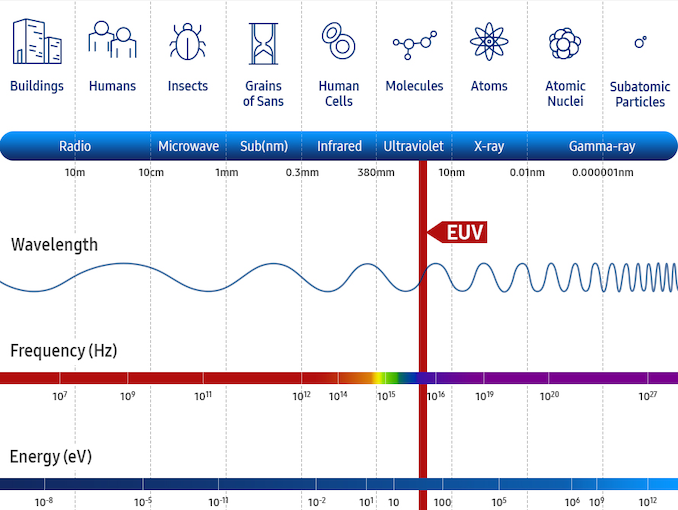Samsung Starts Mass Production of Chips Using Its 7nm EUV Process Tech
by Billy Tallis & Anton Shilov on October 17, 2018 6:00 PM EST- Posted in
- Semiconductors
- Samsung
- EUV
- 7nm
- Samsung Foundry
- 7LPP
Samsung Foundry on Wednesday said that it had started production of chips using its 7LPP manufacturing technology that uses extreme ultraviolet lithography (EUVL) for select layers. The new fabrication process will enable Samsung to significantly increase transistor density of chips while optimizing their power consumption. Furthermore, usage of EUVL allows Samsung to reduce the number of masks it requires for each chip and shrink its production cycle.
New Tech Brings in Big Gains
The maker of semiconductors says that 7LPP fabrication technology enables a 40% area reduction (at the same complexity) along with a 50% lower power consumption (at the same frequency and complexity) or a 20% higher performance (at the same power and complexity) when compared to 10LPE. As it appears, usage of extreme ultraviolet lithography for select layers enables Samsung Foundry to place more transistors inside its next-gen SoCs and reduce their power consumption, a very compelling proposition for mobile SoCs that will be used inside future flagship smartphones.
| Advertised PPA Improvements of New Process Technologies Data announced by companies during conference calls, press briefings and in press releases |
||||||||
| 14LPP vs 28LPP |
10LPE vs 14LPE |
10LPE vs 14LPP |
10LPP vs 10LPE |
10LPU vs 10LPE |
7LPP vs 10LPE |
|||
| Power | 60% | 40% | 30% | ~15% | ? | 50% | ||
| Performance | 40% | 27% | >10% | ~10% | ? | 20% | ||
| Area Reduction | 50% | 30% | 30% | none | ? | 40% | ||
Samsung produces its 7LPP EUV chips at its Fab S3 in Hwaseong, South Korea. The company can process 1500 wafers a day on each of its ASML Twinscan NXE:3400B EUVL step and scan systems with a 280 W light source. Samsung does not say whether it uses pellicles that protect photomasks from degradation, but only indicates that usage of EUV enables it to cut the number of masks it requires for a chip by 20%. In addition, the company says that it had developed a proprietary EUV mask inspection tool to perform early defect detection and eliminate flaws early in the manufacturing cycle (which will likely have a positive effect on yields).
Samsung Foundry does not disclose the name of its customers that that first to adopt its 7LPP manufacturing technology, but only implies that the first chips to use it will be aimed at mobile and HPC applications. Usually, Samsung Electronics is the first customer of the semiconductor unit to adopt its leading-edge fabrication processes. Therefore, expect a 7nm SoC inside Samsung’s high-end smartphones due in 2019. Furthermore, Qualcomm will use Samsung’s 7LPP tech for its “Snapdragon 5G mobile chipsets”.
“With the introduction of its EUV process node, Samsung has led a quiet revolution in the semiconductor industry,” — said Charlie Bae, executive vice president of foundry sales and marketing team at Samsung Electronics. “This fundamental shift in how wafers are manufactured gives our customers the opportunity to significantly improve their products’ time to market with superior throughput, reduced layers, and better yields. We’re confident that 7LPP will be an optimal choice not only for mobile and HPC, but also for a wide range of cutting-edge applications.”
Advanced IP and Packaging: Ready for 7LPP
Samsung’s 7LPP manufacturing technology offers impressive advantages over the company’s 10LPE specifically for mobile SoCs. Meanwhile, in a bid to make the process attractive to a broad range of potential customers, the foundry offers a comprehensive set of design-enablement tools, interface IP (controllers and PHY), reference flows, and advanced packaging solutions. The final PDK is months away, but many customers may start development of their 7LPP SoCs even with existing set of solutions.
At this point 7LPP is supported by numerous Samsung Advanced Foundry Ecosystem (SAFE) partners, including Ansys, Arm, Cadence, Mentor, SEMCO, Synopsys, and VeriSilicon. Among other things, Samsung and the said companies offer such interface IP solutions HBM2/2E, GDDR6, DDR5, USB 3.1, PCIe 5.0, and 112G SerDes. Therefore, developers of chips of SoCs due in 2021 and onwards, which will rely on PCIe Gen 5 and DDR5, can start designing their chips right now.
As for packaging, chips made using 7LPP EUV technology can be coupled with 2.5D silicon interposer (if HBM2/2E memory is used) as well as Samsung’s embedded passive substrates.
Expanding EUV Capacity
As noted above, Samsung installed EUV production tools at its Fab S3, which still has plenty of DUV (deep ultraviolet) equipment. As EUVL is used only for select layers of 7LPP chips, the relatively limited number of Twinscan NXE:3400B scanners is hardly a problem, but when Samsung’s process technologies will require EUV for more layers, it may need to expand its EUV capacities.
As reported in September, a major increase of EUV lithography usage by Samsung Foundry will happen after it builds another production line in Hwaseong, which was architected for the EUV tools from the start. The fab is set to cost 6 trillion Korean Won ($4.615 billion), it is expected to be completed in 2019, and start HVM in 2020.
33 Years in Development
The launch of commercial production of chips using extreme ultraviolet lithography is a culmination of work by the whole semiconductor industry that began in 1985. Ultimately, EUVL is expected to reduce usage of multi-patterning when producing complex elements of a chip and therefore simplify design process, improve yields, and shrink cycle times (or rather not make them longer in the foreseeable future).
Meanwhile, it was extremely challenging to bring EUV from drawing boards to actual fabs because the technology is extremely complex. It needs all-new step-and-scan systems outfitted with all-new light source, new chemicals, new mask infrastructure, and numerous other components that took years to develop. To learn more about EUV lithography, please check our article from 2016.
Related Reading:
- EUV Lithography Makes Good Progress, Still Not Ready for Prime Time
- Samsung Foundry Updates: 8LPU Added, EUVL on Track for HVM in 2019
- Arm and Samsung Extend Artisan POP IP Collaboration to 7LPP and 5LPE Nodes
- Samsung Foundry Updates: 8LPU Added, EUVL on Track for HVM in 2019
- Samsung Foundry Roadmap: EUV-Based 7LPP for 2018, 3 nm Incoming
- Arm and Samsung Extend Artisan POP IP Collaboration to 7LPP and 5LPE Nodes
- Samsung’s 8LPP Process Technology Qualified, Ready for Production
- Samsung and TSMC Roadmaps: 8 and 6 nm Added, Looking at 22ULP and 12FFC
- TSMC Details 5 nm Process Tech: Aggressive Scaling, But Thin Power and Performance Gains
- TSMC Kicks Off Volume Production of 7nm Chips














42 Comments
View All Comments
shabby - Wednesday, October 17, 2018 - link
In other news Intel starts its new and improved 14nm+++ process...Amandtec - Wednesday, October 17, 2018 - link
Which they will review themselves and cool with a 1000W cooler hidden under the table.Gondalf - Thursday, October 18, 2018 - link
At least it yields, allowing billions of net profit.nevcairiel - Thursday, October 18, 2018 - link
This is a low power process though, big difference the desktop chips Intel makes.bobhumplick - Sunday, October 28, 2018 - link
nevcairiel exactlybobhumplick - Saturday, November 2, 2019 - link
yep. all these clickbait articles and vids going around awhile back about amd outselling intel 2 to 1. but thats at 1 retailer that only sells boxed cpus right after the launch of amd's lineup and months after the launch of intels (when everybody that wanted one already has one).for the price of a boxed i5 9400 a dell factory in asia can probalby build a complete i5 9400 system. and none of the factories makes these machines with amd parts because all amd has are 14nm\12nm apus with only 4 cores. while intel has a complete lineup with bundled nic, chipset, cpu etc that actually means intel machines are cheaper to make.
i would say intel outsells amd 20 to 1 at least. probably 50 to 1. its just you dont see those machines. yet they outnumber people almost everywhere we work
all intel has to do, is release cometlake with a 6\12 i5 for 250 ish and a 8\16 i7 (350 ish). get the k- model i5, get a 100 dollar z490 board and get some ram (my z370 pro4 was 110 at launch). overclock (actually near 5ghz will probably be stock) and you have gaming performance that beats amd's whole lineup.
i know not everybody just games but in desktops gaming is the driving force, the only expanding segment in a shrinking market. if you need a 12 core on mainstream then get amd. but what i just said has 90% of the population covered.
and all those people that are only gaming who said that the difference in performance between an intel or amd system in gaming are all of a sudden buying 500 dollar 12 core cpus....that game worse than 330 dollar 8700ks, and soon to be 250 dollar i5's.
deil - Thursday, October 18, 2018 - link
Even if all they gain from another take on 14nm is better yeld, hey should feel free to do so. Maybe next AMD product will force them to lower the price.bobhumplick - Saturday, November 2, 2019 - link
intel should lower consumer prices (boxed processors etc) but their real customers, oems etc, actually get really good prices, buying in bundles for the billions of office pc's and laptops. a dell factory, making the cheapest entry business i5 9400 system can probalby make that whole system for the price of an i5 9400.and yields on 14nm are awesome compared to anything else.
and remember those clickbait vids\articles about zen 2 yielding 70% and intel 35%. i mean sure the full 28 core die might only yield 35%, but take a core off and its still sellable so that actually yielded something. its not 65% of 28 core dies are thrown in the trash. plus that is including all the mesh etc
geeze what a ridiculous statement. comparing a 70mm2 8 core chiplet (not even factoring in io die etc) against a 700mm2 intel 28 core die
bobhumplick - Saturday, November 2, 2019 - link
honestly....really....without a doubt...amd HAS to have a PR\marketing firm or division that just goes around and posts this same comment on EVERY SINGLE ARTICLE AND VIDEO KNOWN TO MAN, even when IT ISNT EVEN ABOUT INTELisofilm - Wednesday, October 17, 2018 - link
If true, had to start without pellicles (not perfected yet), in order to not be totally shamed by having to ship international Galaxy S10's with 7nm Snapdragon 8150 from competitor TSMC. Already confirmed to ship S10's to all US and other major countries using 7nm Snapdragon 8150 TSMC chips (as usual).